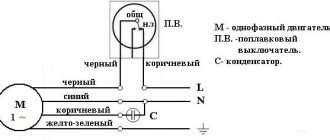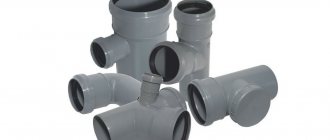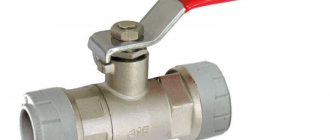Functions of a sealed toilet seal
A replaceable gasket between the cistern and the toilet provides a tight seal, preventing water from leaking out during flushing, creating a threat of flooding to neighbors. If your tank is leaking, an urgent replacement is required. Over time, this part can dry out and crack, which reduces the tightness of the gasket under the tank.
Leaks appear gradually. Under the influence of water, the rubber seal between the tank and the toilet continues to deteriorate. To avoid consequences, the old gasket must be removed and a new one installed in its place.
Types of plumbing gaskets
Gaskets for the cistern and toilet can be sealing or shock-absorbing. Products of the second type are sometimes used in more expensive models of plumbing fixtures, thanks to which the upper and lower parts do not touch each other. Rubber or silicone can be used to make accessories, and various forms of sealed gaskets are also provided:
- Round. The most common variety. They are distinguished by increased thickness; white or black rubber is used for production. Sometimes you can find cheap foam rubber pads, but their actual service life does not exceed 3 days;
- Oval. They were actively used in the production of old types of equipment; modern devices are rarely equipped with them. Such seals were made of dense rubber, functioned for a long time, but required a lot of force to press the seal during installation;
- Trapezoidal. Another rare variety. A significant drawback of the trapezoidal gasket between the tank and the toilet is the use of connecting screws. The advantage is durability and high reliability of fixation;
- Universal. Its outer side has a smooth texture and a round shape; an equilateral hexagon is cut out from the inside. The area adjacent to the toilet elements has a wave-like shape. Guarantees reliable fixation even with low bolt tension.
Types of sealing products
Known types of sealing products differ both in their configuration and in the size and material from which they are made. Each of these signs has its own characteristics.
Seal shape
In accordance with this feature, toilet cuffs are divided into the following groups:
- oval, resembling a regular ring,
- trapezoidal seals,
- cone products,
- gaskets of complex multi-circuit configuration.
Toilet O-rings are the most common type of seal used to connect the bowl and cistern.
They are used in most classic old-style designs. In modern models, gaskets of a more complex shape, resembling a truncated cone, are usually installed.
Recently, trapezoidal seals, which look like a triangle with cut off corners, have become increasingly common in foreign-made products.
In addition to the shape of the cuffs, all of them are characterized by another important property that determines the performance characteristics of the product. It involves classification according to the type of material used in the manufacturing process.
Material
Based on this feature, all known samples of seals are divided into the following types:
- elastic cuffs, which are among the most popular and cheapest products,
- silicone blanks, characterized by increased elasticity and higher cost,
- polyurethane seals, which are the most expensive in their class.
Rubber cuffs are easy to produce and have a relatively low price. This comes at the cost of poor wear resistance and the need for frequent replacement. In contrast, expensive polyurethane products are very elastic, retain their shape well and have a long service life.
When to change the gasket
Gaskets that are placed between the tank and the toilet do not have a dimensionless service life. Due to constant contact with water, it gradually wears out, and therefore the gasket needs to be replaced. The following signs indicate the need to install a new seal:
- Water is leaking from under the storage tank. Make sure that moisture accumulated on the surface of fastening and insulating elements does not condense;
- Cracks are visible on the surface of the gasket. Through them, water penetrates outward, gradually expanding the resulting passage;
- Loss of elasticity - checked by feeling. The rigid element is not able to provide sealing.
Causes
If you hear the unusual sounds of constantly filling water in the bathroom, you should definitely check whether there is a leak in the plumbing structure. Problems with flushing can often indicate a similar problem. Most often, repairs can be done with your own hands, since the design of the toilet and cistern is quite simple.
The main causes of leakage include:
- Problems with the drain tank. It works on the principle of a water seal. There is a lever, a float and a seal. As a result, as soon as the liquid reaches a certain level, a valve is activated, which shuts off the water. If the system is broken, water will either simply constantly flow into the toilet or overflow over the top.
- Corrugation wear. This may be the reason why water is entering the floor from below. It is easy to change.
- Leak directly between the toilet and the cistern. Here everything is somewhat more complicated, since the presence of water in this area indicates depressurization of the structure. And the most common cause of failure is deformation of the sealing elements. These are rubber gaskets that need to be replaced with new ones.
- Rusty bolt. This is the connecting element that holds the entire structure. There may be several such bolts. They periodically unwind, and sometimes they rust so badly that their further use is out of the question. In this case, there is only one way out - replacing the worn-out element.
How to change the gasket between the toilet and the tank
The gasket is replaced in two stages.
Stage 1: dismantling the plumbing
Before you begin disassembly, you need to turn off the water supply. Next, the following actions are performed sequentially:
- Removing the cover. On some models, to do this, you need to unscrew the lock, which has a built-in drain button;
- all water is removed from the tank;
- in the internal space the water supply pipe is turned off;
- the locknut securing the siphon is unscrewed;
- remove the bolts securing the tank to the toilet, if any;
- The tank is mounted on the toilet shelf. The container is carefully removed from it so as not to break or damage the surface.
Older toilets often used metal bolts. They are susceptible to corrosion, making dismantling difficult. If it is impossible to unscrew a rusted bolt, you need to use WD-40 liquid, which can be used to remove the rust. A similar result can be achieved through the use of kerosene.
Stage 2: Install the gasket
After the storage tank is dismantled, the following actions should be performed:
- eliminate the outdated gasket;
- Before installing a new one, you should prepare the base. It is cleaned of dirt, scale, and other foreign substances, and then dried with a rag;
- a new seal is installed to replace the previous one;
- to achieve the required tightness, the surface of the gasket is lubricated with silicone sealant;
- The tank is reinstalled and secured with screws. The fastener must be tightened carefully - excessive force may damage the housing;
- connecting all fittings inside the tank using a locknut;
- installing a water supply hose.
Once finished, you need to wait a few hours for the sealant to go through the polymerization process and ensure complete sealing of the joint. Additionally, you can foam the gaps remaining between the tank and the toilet. Some time after installation, you should check the condition of the toilet.
Replacement procedure
The operation of updating the gasket is not so complicated that a person completely unfamiliar with plumbing could not cope with it. In order to correctly change the sealing element under the toilet tank, first of all you should consider how to attach it to the base of the bowl.
Note! Based on this feature, all systems are divided into two types: the first involves fixing the tank for drainage on a special shelf, and the second is characterized by an independent position of the fastening zone.
On the shelf
The cuff is mounted on the shelf of the bowl base. The advantage of this arrangement is the compactness and ease of maintenance of the compaction area.
Note! This method is not without some disadvantages, manifested in the low pressure of the drained liquid.
Before you remove the old one and start installing the new gasket, you should first turn off the water supply valve and disconnect the supply hose from the tank.
Then the water is completely drained from it (you can use a special valve for this), and then the mounting bolts are removed. When disassembling the bolted joint, you need to act very carefully, trying not to damage the fragile porcelain (otherwise it may simply crack).
The next step is to remove the tank and dismantle the seal that has become unusable.
Before installing the new cuff, a layer of silicone sealant should be applied to the base of the toilet, which will help fix it and prevent it from moving too much to the side.
Separate location
Such a toilet has one advantage, which is the strong pressure of the flushed water supply. In it, the drain pipe is attached to the bowl of the model and is sealed inside the structure in one way or another, depending on the shape of the receiving neck.
Most often, it has an extension with a cap collar, which ensures reliable articulation of the two parts built into the monolith. One of the variations of this option is the use of special petal-type transition cuffs.
These products look like rubber couplings with a wide outer diameter that matches the cross-section of the flush pipe with the inner neck. When installing such a joint inside the structure, all its elements are lubricated with a layer of sealant.
Temporary troubleshooting
Sometimes a problem is discovered at the most inopportune moment. Delay may result in a serious accident or create inconvenience due to the cessation of normal operation of the bathroom. In this case, the only option is to temporarily repair the damage. There are several ways:
- Cut a miniature strip of fabric and soak it with oil paint. With the help of an assistant, lift the cistern while he wraps a strip of fabric around the damaged part. To improve the result, you should tie a rag with twine, then lower the tank and install all the internal elements. You can turn on the water only after the paint has dried;
- Use a rubber band. It can be purchased at 24-hour pharmacies. Its length, width and thickness should be 1 meter 5 and 1-2 millimeters, respectively. Having stretched the tape, you need to use it to wrap the damaged gasket. Fixation is carried out using rust-resistant copper wire.
How to choose
When it comes to choosing and replacing a gasket, many people get confused, since you can find many different parts in a plumbing store. They can be made of rubber, silicone or polyurethane, and come in different shapes and lengths. Often there are identical products with the same dimensions from different manufacturers. To ensure that the selected sealing element meets your expectations, you need to follow several rules:
- the product must be made of an elastic material that is sufficiently soft and elastic;
- the shape must correspond to the toilet model on which the new gasket will be installed;
- The seal must be free of defects. Sometimes sellers offer customers parts that are already dry and unsuitable for use. Make sure there are no cracks or sagging on the gasket.
Remembering the product in your hands before purchasing is the best way to evaluate the elasticity and flexibility of the product without risking damage to it. If you are not sure which part you need, dismantle the toilet, remove the old gasket and bring it to the store as a sample.
If you are making a choice between a cheap domestic or expensive imported gasket, think about the ratio of quality and price. More expensive seals can last longer and be of better quality, although they will cost more.











